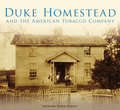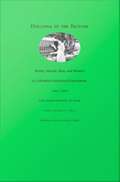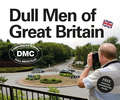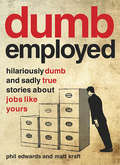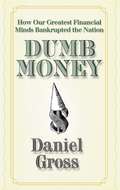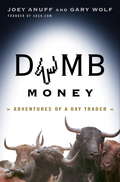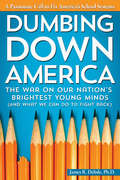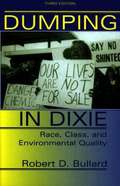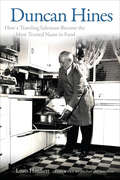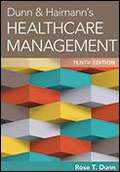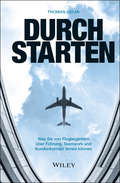- Table View
- List View
Duke Heart Failure Program
by Richard Bohmer Laura R. FeldmanDuke University Health System has for the past five years operated a specialized clinic for the management of congestive heart failure, a very common and costly condition in the surrounding community. Nurse practitioners, whose work is guided by highly specified protocols and overseen by cardiologists, staff the multidisciplinary clinic. The chancellor of the health system views the program as a huge financial burden and an undesirable use of academic cardiologists' time. The case examines models of disease management; Duke's heart failure program operations, finances, and outcomes of disease management; and the relationship between its nurse practitioners and cardiologists.
Duke Homestead and the American Tobacco Company
by Jennifer Dawn FarleyShaped by the Duke family's influence and the production of bright leaf tobacco, Durham, North Carolina, over time, has transformed from the "Bull City" to the "City of Medicine." Duke Homestead and the American Tobacco Company showcases the effect of both tobacco and the Duke family in Durham. The Duke family's fortunes grew alongside those of the city as they rose from tobacco farmers to founders of the American Tobacco Company and influential philanthropists. Duke University, Duke Hospital, and Duke Energy as well as local churches, orphanages, textile mills, banks, and railroads can all trace their roots to the Duke family. The American Tobacco Company was the largest tobacco manufacturer in the world as well as one of the 12 founding members of the Dow Jones Industrial Average. From its founding in 1890, the American Tobacco Company was a major employer in the area, bringing income and a higher quality of life to those employed there, regardless of race or gender.
Dulcinea in the Factory: Myths, Morals, Men, and Women in Colombia's Industrial Experiment, 1905-1960
by Ann Farnsworth-AlvearBefore it became the center of Latin American drug trafficking, the Colombian city of Medelln was famous as a success story of industrialization, a place where protectionist tariffs had created a "capitalist paradise. " By the 1960s, the city's textile industrialists were presenting themselves as the architects of a social stability that rested on Catholic piety and strict sexual norms. Dulcinea in the Factory explores the boundaries of this paternalistic order by investigating workers' strategies of conformity and resistance and by tracing the disciplinary practices of managers during the period from the turn of the century to a massive reorganization of the mills in the late 1950s. Ann Farnsworth-Alvear's analyses of archived personnel records, internal factory correspondence, printed regulations, and company magazines are combined with illuminating interviews with retired workers to allow a detailed reconstruction of the world behind the mill gate. In a place where the distinction between virgins and nonvirgins organized the labor market for women, the distance between chaste and unchaste behavior underlay a moral code that shaped working women's self-perceptions. Farnsworth-Alvear challenges the reader to understand gender not as an opposition between female and male but rather as a normative field, marked by "proper" and "improper" ways of being female or male. Disputing the idea that the shift in the mills' workforce over several decades from mainly women to almost exclusively men was based solely on economic factors, the author shows how gender and class, as social practices, converged to shape industrial development itself. Innovative in its creative employment of subtle and complex material, Dulcinea in the Factory addresses long-standing debates within labor history about proletarianization and work culture. This book's focus on Colombia will make it valuable to Latin Americanists, but it will also appeal to a wide readership beyond Latin American and labor studies, including historians and sociologists, as well as students of women's studies, social movements, and anthropology.
Dull Men of Great Britain: Celebrating the Ordinary (Dull Men's Club)
by Leland CarlsonNeil collects bricks, Kevin is a roundabout enthusiast, John runs the Apostrophe Protection Society and Keith’s actual job is watching paint dry. They are members of the Dull Men’s Club and are passionate about the everyday, unglamorous things in life. They are dull and proud and urge the good ordinary men of the nation to join them now. Whether you have a thing for pylons or rhubarb, reclaim and celebrate the ordinary. Includes Free Honorary Membership.Predictable * Reliable * Safe
Dumb Employed: Hilariously Dumb and Sadly True Stories about Jobs Like Yours
by Phil Edwards Matt KraftIf you've ever wanted to crawl under your desk at work and hide, or tell that pesky coworker what you really think of them, you are probably dumbemployed! Dumbemployed includes approximately 800 of the best, funniest, and dumbest stories contributed by readers from dumbemployed. com, with ninety percent brand-new material! In 300 characters or less, each entry details the stupid, bizarre, and ridiculous things that happen in the workplace. Entries are divided into five chapters and are complemented throughout with Dumbemployed Tips, humorous charts and graphs, and room to write your very own Dumbemployed entries.
Dumb Money
by Daniel GrossThe financial crisis that has gripped this country since last September has had so many twists and turns, it would make for a great drama -- if it all were not so real and damaging. Companies are shutting down and laying off workers, 401ks are melting away, and the government is spending $700 billion dollars to bail out banks and financial institutions -- and that's only the beginning. The financial services industry, and the many industries that depend on it -- from housing to cars -- is in intensive care. So what happened? How did we get to this point of financial disaster? Is the economy just a huge, Madoff-esque Ponzi scheme? It is a complicated and confusing story -- but Daniel Gross of Newsweek has a special gift for making complicated matters easy to understand and even entertaining. In Dumb Money, he offers a guide to the debacle and to what the future may hold. This is not so much a book about who did what, though that's part of the story. Rather, it pieces together the building blocks of the debt-fueled economy, and distills the theory and personalities behind our late, lamented easy money culture. Dumb Money is a book that finally lays it all out in an engaging way, and might just help people invest their money smartly until the gloom passes.
Dumb Money
by Gary Wolf Joey AnuffAs you read this, five million Americans are day-trading. Not since gold was discovered in California have more people dropped out of their old lives and come running for the promise of a big score. For a time, Joey Anuff was among them. He has emerged-enriched, enlightened, and exhausted-to share his story. In a marriage of Anuff's own experiences with the brilliant investigative work of his Wired and Suck colleague Gary Wolf, Dumb Money explores and explains the world of day-trading as has never been done before. No strategy is too crackpot to try, no news break too dubious to play off, no so-called guru too shady, no online chat room too pathetic. Using the rhythms of a day trader's typical day as its frame, Dumb Money is a dispatch from the front lines of the stock-market revolution, a brutally Darwinian battleground on which some become wildly rich and more become part of the body count. It is essential reading for online investors, off-line investors, voyeurs, concerned citizens, and adrenaline freaks alike.
Dumb Ways To Die: Advertising Train Safety (A)
by John A. QuelchThe case series focuses on Melbourne Trains' viral advertising campaign to improve safe behaviors around trains among young people. This iconic, low budget campaign swept the Cannes Lions advertising awards in 2013 and became a social media sensation.
Dumb Ways To Die: Advertising Train Safety (B)
by John A. QuelchThe case series focuses on Melbourne Trains' viral advertising campaign to improve safe behaviors around trains among young people. This iconic, low budget campaign swept the Cannes Lions advertising awards in 2013 and became a social media sensation.
Dumb Ways To Die: Advertising Train Safety (C)
by John A. QuelchThe case series focuses on Melbourne Trains' viral advertising campaign to improve safe behaviors around trains among young people. This iconic, low budget campaign swept the Cannes Lions advertising awards in 2013 and became a social media sensation.
Dumbing Down America: The War on Our Nation's Brightest Young Minds (And What We Can Do to Fight Back)
by James DelisleAt a time when the U.S. education system consistently lags behind its international peers, Dumbing Down America shows exactly why America can't keep up by providing a critical look at the nation's schools through the eyes of the children whose minds are languishing in countless classrooms. Filled with specific examples of how gifted children are being shortchanged by a nation that believes smart kids will succeed on their own, Dumbing Down America packs a powerful message: If we want our nation to prosper, we must pay attention to its most intelligent youth. With more than 35 years of experience working with and for gifted children, author James R. Delisle provides a template of what can and must happen in America's schools if they are to fulfill their mission of educating every child to the fullest potential. Dumbing Down America is a must-read for any individual who believes that the unfulfilled promises to gifted children must begin to be met in America's schools today, not someday.
Dumbing Down: The Crisis of Quality and Equity in a Once-Great School System—and How to Reverse the Trend
by Magnus Henrekson Johan WennströmThis open access book examines the challenges and issues caused by a move to a marketized education system in Sweden. Observing the introduction of the school voucher system and a postmodern social constructivist view of knowledge, the move away from objective knowledge is identified as the core reason for Sweden’s current education crisis. The impact of declining education standards on the labor market is also discussed.This book highlights the issues seen in Sweden and suggests policies that can improve education in the rest of the Western world as well. It will be relevant to students and researchers interested in education and labor economics.
Dumping in Dixie: Race, Class, and Environmental Quality (3rd Edition)
by Robert D. BullardTo be poor, working-class, or a person of color in the United States often means bearing a disproportionate share of the country's environmental problems. Starting with the premise that all Americans have a basic right to live in a healthy environment, Dumping in Dixie chronicles the efforts of five African American communities, empowered by the civil rights movement, to link environmentalism with issues of social justice. In the third edition, Bullard speaks to us from the front lines of the environmental justice movement about new developments in environmental racism, different organizing strategies, and success stories in the struggle for environmental equity.
Duncan Hines: How a Traveling Salesman Became the Most Trusted Name in Food
by Louis HatchettThis delightful biography &“offers conclusive proof that Hines was not only a real human being, but an American culinary hero&” (The Weekly Standard). Duncan Hines may be best known for the cake mixes, baked goods, and bread products that bear his name, but many people don&’t know that he was a real person and not just a fictitious figure invented for the brand. America's pioneer restaurant critic, Hines discovered his passion while working as a traveling salesman during the 1920s and 1930s—a time when food standards were poorly enforced and food safety was a constant concern. He traveled across America discovering restaurants and offering his recommendations to readers in his bestselling compilation Adventures in Good Eating—and the success of this work and his subsequent publications led Hines to manufacture the extremely popular food products that we still enjoy today. In this biography, Louis Hatchett explores the story of the man, from his humble beginnings in Bowling Green, Kentucky, to his lucrative licensing deal with Procter & Gamble. Following the successful debut of his restaurant guide, Hines published his first cookbook at age fifty-nine and followed it with The Dessert Book—culinary classics including recipes from establishments he visited on his travels, favorites handed down through his family for generations, and new dishes that contained unusual ingredients for the era. Many of the recipes served as inspiration for mixes that eventually became available under the Duncan Hines brand. This is a comprehensive account of the life and legacy of a savvy businessman and an often-overlooked culinary pioneer whose love of good food led to his name becoming a grocery shelf favorite.
Dunkin' Donuts (C): Growth Strategy
by Hirotaka TakeuchiDunkin' Donuts franchises and operates retail donut shops for take-home and in-shop consumption. Looks at three growth alternatives: 1) More shops (owned or franchised); 2) A broader product line; and 3) More advertising. Raises important issues related to franchise relations. A merger of Dunkin' Donuts (A) and (B).
Dunkin' Donuts (E): 1988 Distribution Strategies
by Patrick J. KaufmannDunkin' Donuts is exploring various methods of increasing distribution. Possibilities involving new outlets include area development contracts, subfranchising, regional rollout strategies, and an increase in company owned stores. Possibilities focusing on existing shops include sales of branded products through convenience stores and satellite (non-producing) retail outlets. The case provides consumer data and detailed information about regional differences, franchise relations, and shop operations. Raises issues relating to both strategy formulation and implementation in a franchise system and requires the student to analyze the interaction between the structure and management of a franchise system, and how they both relate to the market.
Dunn and Haimann's Healthcare Management
by Rose T. DunnThe challenges facing the healthcare industry today will require fine-tuned managerial skills. Healthcare managers must keep pace with revolutionary and sophisticated breakthroughs in medical science and technology, transparency of service outcomes and charges, an educated customer base, an aging population, and federal regulations growing exponentially. At the center of all these changes is the supervisor, who has to bring and hold together the human resources, physical facilities, professional expertise, technologies, and other support systems necessary to provide care and monitor services rendered. In addition, these tasks have to be accomplished within the fiscal constraints of a more efficient healthcare system. Therefore, healthcare managers and supervisors must understand the complexities of the organization, generational motivational differences, regional healthcare demands, and the industry as a whole.
Durch Markenführung und Innovation zu mehr Nachhaltigkeit im Unternehmen: Wie Sie Nachhaltigkeit bei gleichzeitigem wirtschaftlichen Erfolg erreichen (Edition Nachhaltig wirtschaften)
by Christian Schlimok Bastian von LehstenDas Buch zeigt, wie Unternehmensstrategie, Markenstrategie und Nachhaltigkeitsstrategie effizient kombiniert werden können. Die Autoren erklären, wie Markenführung und Innovation in verknüpfter Form mehr Nachhaltigkeit in Unternehmen erzeugen und welch schmaler Grat oft zwischen Green Marketing und Greenwashing liegt. Sie analysieren die Bedeutung von ganzheitlicher Markenführung und Innovationsprozessen und zeigen auf, wie Unternehmen daraus wirtschaftlichen Erfolg erzeugen und nachhaltiger agieren können. Außerdem geben sie Handlungsimpulse für die eigene Markenkommunikation im Zusammenspiel mit Innovationsmanagement und Nachhaltigkeitsstrategie.
Durch die Glasdecke: Wie Frauen die Gender Negotiation Gap schließen und am Verhandlungstisch überzeugen
by Simone Burel Jana BachmannBraucht die Welt ein Buch über gegenderte Verhandlungsstrategien? Macht es überhaupt einen Unterschied, wer mit wem verhandelt? Ja und nein. Nein, weil ein Großteil des Handwerkszeugs von guten Verhandler*innen nicht geschlechtlich codiert ist. Ja, weil sich einige Aspekte einer erfolgreichen Verhandlung geschlechtlich unterscheiden. Dieses Buch klärt auf, welche wissenschaftlichen Erkenntnisse es über die geschlechtlichen Unterschiede bei Verhandlungen gibt. Es wirft einen vertieften Blick auf Verhandlungen im Arbeitskontext, da diese den Weg für Karriereschritte ebnen oder verbauen können. Anhand eines Verhandlungs-Toolkit werden hilfreiche Werkzeuge hinsichtlich Vorbereitung, Durchführung und Evaluation einer Verhandlung vorgestellt und es wird erläutert, worauf Frauen und Menschen aus Minderheiten insbesondere achten sollten. Dazu zeigt es Verhandlungsstrategien auf: Wie kann ich meinen potenziellen Verhandlungsnachteil als Frau/Mensch einer Minderheit ausgleichen bzw. nutzen, um davon zu profitieren? Letztlich hilft das Buch Unternehmen und HR-Spezialist*innen, eine inklusive Verhandlungskultur zu etablieren.
Durch die Krise führen: Die transformative Kraft einer Pandemie (essentials)
by Andreas SeitzWir befinden uns im Transformationszeitalter. Organisationen und ganze Volkswirtschaften sind im tiefgreifenden Wandel begriffen. Dieses essential zeigt Ihnen, welche Chancen und Risiken Krisen – aktuell die Covid-19-Pandemie – für diesen Wandel mitbringen. Und wie es aus Führungssicht gelingen kann, die Kräfte der weltweiten Krise für die Gestaltung der Zukunft zu bündeln. Neben der Betrachtung von Chancen und Gefahren illustrieren Modelle, Prozesse und Erkenntnisse aus unterschiedlichen Disziplinen, wie Führungskräfte die transformative Kraft der Krise nutzen können.
Durch die berufliche Krise und dann vorwärts –: wie Sie in und nach der Krise auf den Beinen bleiben
by Heidrun Schüler-Lubienetzki Ulf LubienetzkiDieser Ratgeber vermittelt erprobtes Handwerkszeug, um auch bei schweren beruflichen Krisen wieder zum eigenen Wohlbefinden zu finden. Ein besonderes Augenmerk legt das leicht verständliche Buch auf das frühzeitige Erkennen der sich abzeichnenden Krise, sowie die Krisenprävention. Gerade die Prävention, soviel sei an dieser Stelle bereits verraten, beginnt immer bei Ihnen selbst. Seien Sie daher neugierig und bereit, Neues über sich zu erfahren und für sich zielführende Schlüsse zu ziehen. Anschauliche Beispiele aus der Praxis werden Sie dabei unterstützen, das neue Wissen sowie die vielfältigen Tools und Tipps auf Ihre persönliche Situation zu übertragen. Betroffene und Menschen, die mit Betroffenen arbeiten, erhalten entscheidende Blicke auf zielführende Wege und Möglichkeiten des Handelns aus der beruflichen Krise. Zielgruppen: Menschen, die von Krisen betroffen sind, und Menschen, die sich bei Zeiten für mögliche Krisen wappnen möchtenPersonalentwickler, Coaches, Berater und Trainer, die mit Menschen in Krisensituationen arbeiten, erhalten vielfältige Anregungen und Perspektiven für den Umgang mit beruflichen Krisen ihrer Klienten Zu den Autoren: Diplom-Psychologin Heidrun Schüler-Lubienetzki und Diplom-Ingenieur Ulf Lubienetzki arbeiten seit mehr als zwei Jahrzehnten mit Menschen in unterschiedlichen beruflichen Konstellationen zusammen. Bei ihrer Arbeit als Coaches, Trainer und Berater sind die häufigsten Themen ihrer Klienten: mit beruflichen Krisen umzugehen und diese zu bewältigen. Heidrun Schüler-Lubienetzki und Ulf Lubienetzki geben ihre Erfahrung und ihr Wissen als vielfache Fach- und Lehrbuchautoren mit Freude an ihre Leser weiter.
Durchstarten: Was Sie von Flugbegleitern über Führung, Teamwork und Kundenkontakt lernen können
by Thomas GelmiWas tagtäglich in Unternehmen passiert, vergleicht Thomas Gelmi mit der Welt an Bord einer Passagiermaschine. Was in einem Flieger auf 10.000 Metern Flughöhe geschieht, ist wie eine eigene kleine Welt - weiß der ehemalige Purser und Maître de Cabine bei der damaligen Swissair. In diesem begrenzten Raum eines Flugzeugs treffen Führungskräfte, Mitarbeiter und Kunden aufeinander. Sie treten in Interaktion oder begegnen Konflikten, wie man sie auch in anderen Business-Bereichen findet. Wie sich diese Interaktion gestaltet, ist stark vom Können und Wirken der Kabinenbesatzung abhängig, welche Herausforderungen im besten Fall voraussehen und de-eskalieren und im schlimmsten Fall sofort ohne Hilfe von außen lösen muss. Dafür ist höchste Selbst- und Beziehungskompetenz gefordert. Mit allen Konsequenzen. Was also können Führungskräfte vom Setting "on board" lernen? Das Buch durchleuchtet die Herausforderungen an die Selbst- und Beziehungskompetenz in den Bereichen Leadership, Teamwork, Kundenkontakt und Privatleben. Welche Grundhaltungen und Verhaltensweisen sind dort jeweils hilfreich, oder sogar nötig, damit "der Flieger oben bleibt" und nicht zu einer Notlandung ansetzen muss? Was bedeutet das für die Selbst- und Beziehungskompetenz im übertragenen Sinn? Jedes Kapitel beginnt mit kribbeligen "True Stories", die auf einem bestimmten Breiten- und Längengrad auf 10.000 Metern Flughöhe passiert sind. Der Leser erkennt direkt Parallelen zu seinem Leben, spürt Probleme schneller auf und findet selbst Lösungswege. Wer in seinem Beruf seinen Wirkungsgrad steigern möchte, kommt an diesem Buch nicht vorbei.

